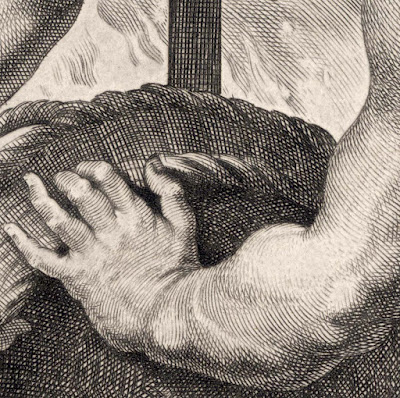Lucas Vorsterman (I)
(aka Lucas Aemilius Vorsterman) (1595–1675)
“The Martyrdom
of St Lawrence”, 1621, after the painting by Peter Paul Rubens (1577–1640) in
the Alte Pinakothek, Munich, published by Lucas Vorsterman I. Note: the curator
of the BM points out that there is also a preparatory drawing by Van Dyck (?) in
The Metropolitan Museum, New York.
Engraving on wove
paper (19th century impression) with margins
Size: (sheet)
44.4 x 31.4 cm; (plate) 39.3 x 28.6 cm; (image borderline) 37.2 x 27.3 cm
Lettered within
the image borderline at bottom left, "Lucas Vorsterman sculp. et excud.
Ao. 1621", in lower margin four lines Latin dedication by Rubens to Laurens
Beyerlinck, left the privilege CPRCPB&OB, right "P. P. Rubens
pinxit"
Schneevoogt
1873 105.100 (C G Voorhelm Schneevoogt 1873, “Catalogue des estampes gravées
d'après P.P.Rubens”, Haarlem); Hollstein 88.II (under Vorsterman) (F W H Hollstein
1949, “Dutch and Flemish etchings, engravings and woodcuts c.1450-1700”,
Amsterdam); see also the impression held by the Rijksmuseum: http://hdl.handle.net/10934/RM0001.COLLECT.346335
The British
Museum offers the following description of this print:
“The Martyrdom
of St Laurence; St Laurence being roasted on a gridiron, pushed by two
torturers on either side; a third man providing wood into the fire in
foreground; two helmeted officers at left, another one on horseback at right;
one priest, one lictor urging the martyr to abjure his faith at centre, other
spectators in the distance; in left background a statue of Jupiter; above a
cherubs holding out a martyr's crown and palm; after Peter Paul Rubens. 1621 Engraving”
(http://www.britishmuseum.org/research/collection_online/collection_object_details.aspx?objectId=1640947&partId=1&searchText=vorsterman+rubens+&page=1)
Condition: exceptional
19th century impression in superb—near pristine—condition (i.e.
there are no tears, holes, folds, stains, abrasions or foxing).
There are pencil notations on the lower edge of the sheet (recto).
I am selling
this large, spectacular and important engraving by one of the finest
reproductive engravers of the 17th century for a total cost of AU$187
(currently US$143.55/EUR136.58/GBP115.29 at the time of this listing) including
postage and handling to anywhere in the world.
If you are
interested in purchasing major print from the Renaissance era, please contact
me (oz_jim@printsandprinciples.com) and I will send you a PayPal invoice to
make the payment easy.
This print has been sold
Vorsterman is
one of the greatest printmakers of the 17th century in terms of the
art of translating colour, texture and tone of paintings into prints. He was
certainly the finest reproductive engraver/etcher of Rubens and Van Dyck’s designs.
Sadly, like most intense and obsessively committed artists, he was prone to
having/creating explosive relationships with those he worked with. Accordingly,
his working relationship with Rubens ended abruptly in 1622—so abruptly that
there was a rumour that Vorsterman may have almost stabbed Rubens to death! From
what I understand, based on what Rubens wrote to Peter van Veen in April 1622,
Vorsterman had delusions of grandeur. Vorsterman’s
falling out with the artistic luminaries of the time, however, simply
redirected his energies into the discipline of being a print publisher and in the
same year of his calamitous disagreement with Rubens he was awarded a six-year publisher’s
privilege from Archduchess Isabella of Austria. Interestingly, this print was
both engraved and published by Vorsterman, but under the privilege (i.e.
copyright) of the Spanish Crown rather than Austria.
Regarding the
privilege inscribed on this plate, it was obtained by Rubens rather than
Vorsterman in 1619. What this granted Rubens was permission to “have copies
made and engraved by an engraver of his choice. Furthermore, it was forbidden
for the next twelve years for anyone else to copy ‘the aforesaid paintings so
depicted and engraved on plates.’” (Carl Depauw & Ger Luijten 1999, “Anthony
van Dyck as printmaker”, Antwerpen Open, p. 387)







No comments:
Post a Comment
Please let me know your thoughts, advice about inaccuracies (including typos) and additional information that you would like to add to any post.